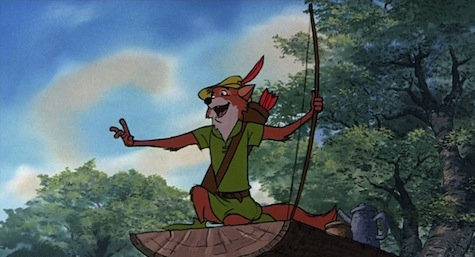Disney’s Robin Hood (1973) is the Robin Hood myth at its most mythic. It has the simplest plot (Robin robs and humiliates John so badly that eventually John throws all of Robin’s friends in jail, leading Robin and Little John to stage an epic jailbreak/heist). It’s divorced from historical context, indeed it is divorced from human characters entirely. The Disney version is Robin Hood as fairy tale: John is a lion who taxes his subjects simply because he loves money, and Robin Hood is a clever fox that robs and gives to the poor, because, well, because that’s what Robin Hood does.
It’s nominally set in England, but only a few characters, like Robin and Prince John, speak with British accents. Other characters sound like they come from all over the United States, notably the narrator, Alan-a-Dale (a rooster), voiced by country singer Roger Miller. And of course few of the animals featured are native to England. Drawing on lots of influences—including Disney’s 1967 version of The Jungle Book—the film moves towards a more universal setting. It’s not just one village in one place at one particular historical moment, but every poor village that ever suffered under an oppressive ruler.
There is no nuance to this movie. Unlike in The Adventures of Robin Hood, almost everyone agrees from the beginning that Robin Hood is a hero and John is a bully. There’s one scene where Little John (a bear) asks whether they’re bad guys for stealing, which Robin laughs off by saying they’re merely “borrowing.” And that’s the end of any ethical dilemma. Even the Sheriff of Nottingham (a wolf) and John’s right hand snake, Sir Hiss, get in on the action of making fun of Prince John, “that phony king of England.”
Which brings us to the most striking thing about Disney’s Robin Hood (after it being an animated version where all the characters are animals): it’s unapologetically a musical. Most of the songs are part of Alan-a-Dale’s folk song narration, but Little John’s rousing dance number “The Phony King of England” is a tune so catchy and insulting that John ends up taxing the entire town of Nottingham into debtors prison after he catches Sir Hiss and the Sheriff singing it.
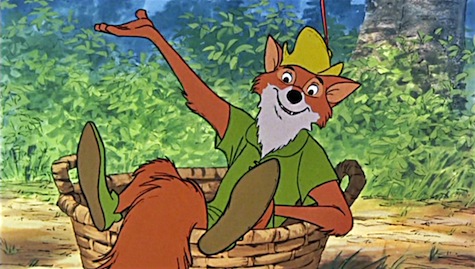
Robin Hood
Brian Bedford’s voice is perfect for Robin Hood. Suave and assured even in the most dire circumstances, and quick to make a joke. He only sounds sad when talking about Maid Marian, whom he lost when he became an outlaw.
Of course, there’s no explanation of why he became an outlaw. We don’t know whether Robin was born noble or common, or if became a thief before or after King Richard left England in the hands of his brother. All we do know is that he grew up with Marian, and that his birth name might in fact be Robin Hood. (He carved their initials in a tree as “R.H. + M.M.” suggesting that her first name is actually “Maid.”)
What we do know is that he shares many of the same traits as the Errol Flynn version: flamboyance, arrogance, generosity, and super flippancy about most things. Even more than Flynn, Bedford’s Robin is explicit about his crimes being “performances” (a word he repeats a few times), and he wears three ridiculous disguises over the course of the film (a female fortune teller, a blind old man, and a young stork archer) to Flynn’s one. It’s all a game to Robin, even the arrow shot though his cap, until his actions get the entire town locked up and his friend Friar Tuck (a badger) almost hanged.
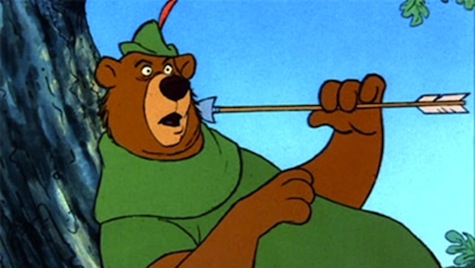
The Merry Men
In Disney’s Robin Hood, it’s not so much the Merry Men as the Merry Man. Robin only has the one official partner in crime: Little John, who’s modeled on—and voiced by the same actor as—Baloo from The Jungle Book. Little John is slightly more cautious than Robin, often warning him not to take risks in challenging Prince John directly, but only slightly. Because he’s just as often quickly running after Robin, getting into his own ridiculous disguise, and acting as back-up knife when Robin gets into trouble.
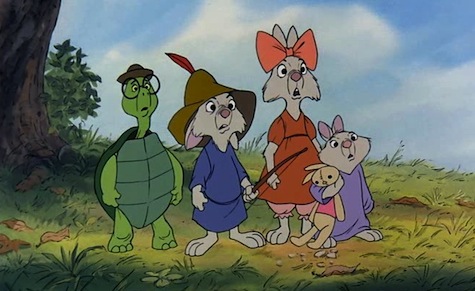
Other famous Merry Men are in the film, they’re just not actually thieves. Friar Tuck is just a friar, trying to take care of the poor church mice that fill his pews. Alan-a-Dale narrates and sings sad songs when he’s arrested. The role of the young man inspired by Robin Hood is filled by Skippy (a rabbit), plus his sister Sis, his brother Tagalong, and his friend Toby (a turtle). In some ways, the kids are the point of view characters; it’s through Skippy that we learn of Robin and Marian’s backstory, with Skippy that we watch the archery contest, and it’s Skippy, wearing Robin’s hat, who helps Little John drive Robin’s wedding carriage away.
There is no Will Scarlett, unless there was a cardinal in the background I missed.
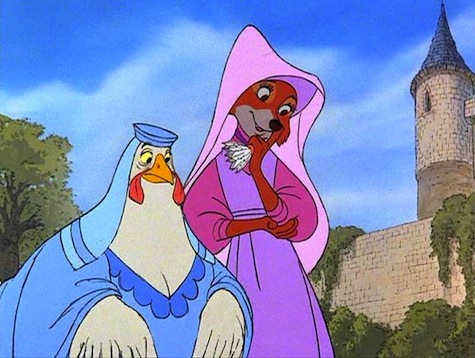
Marian
Maid Marian may be the weakest part of Disney’s Robin Hood. She’s a vixen, which means Disney never has to deal with the ramifications of cross-species romance. She’s never a damsel in distress, which is good. But she doesn’t really do anything else, either. She loves Robin from the beginning (keeping his wanted poster in her bedroom), and she’s sweet to Skippy and his friends when they barge in on her badminton game. But she never saves Robin, and Robin never saves her, and after having a romantic stroll with Robin around Sherwood Forest to the Oscar nominated song, “Love Goes On” she basically disappears from the narrative.
Her maid, Lady Kluck (a chicken and Scottish, for some reason), is the more active player in the story. Kluck is openly contemptuous of Prince John, taking his role as the villain so Skippy can play the hero, loudly declaring “Long Live King Richard” in range of Prince John’s archers, and charging through John’s soldiers like a wide receiver, all to the tune of the University of Wisconsin’s fight song. But she, too, disappears from the climax only to reappear right at the end.
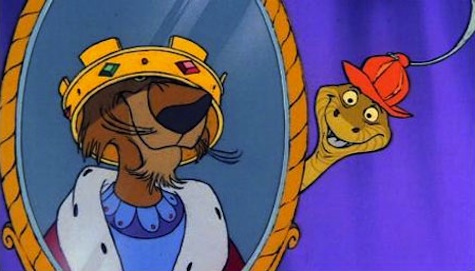
The Bad Guys
Sir Peter Ustinov’s Prince John is the source of most of the humor of the movie. His motives may be simple (he loves money, and sleeps in the treasury), but his characterization is actually complex. He’s a lion, because his brother Richard is obviously a lion, but he’s a scrawny lion, wearing his older brother’s clothes that are way too big for him. He’s a baby who sucks his thumb and calls for his mother when things go poorly. He’s also vain but he’s insecure. He’s vicious, but a coward. He’s suspicious, but of all the wrong people. He’s basically a clown.
Sir Hiss takes the role of Sir Guy, the noble suck up to the Prince. Sir Hiss has an odd multifaceted relationship with John, as he’s John’s minister of finance, best friend, and pet. He literally sleeps at the foot of John’s bed and his tongue tickles John in his sleep. He’s also the most fantastic, “cartoony” character in the movie. Not only can he hypnotize people (like his character model, Kaa), he can also float away in a balloon he himself blew up, and use his tail as a propeller.
With John and Hiss as comic relief, that leaves it to the Sheriff to be the actual threat. He’s a wolf, but he’s bigger than even Little John. When he comes knocking on peasants’ doors looking for taxes, he’s immediately threatening. He also has the high pitched, Alabama accent of Pat Buttram, famous for being Mr. Haney on Green Acres, which again moves the setting from the specific Nottingham of the late 12th century to any town, anywhere.
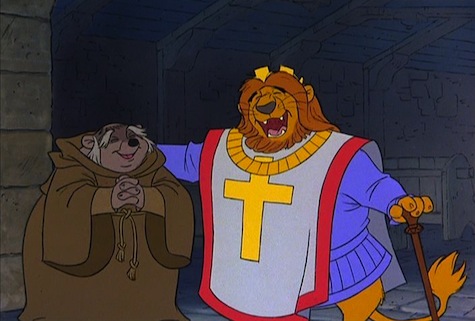
Richard and the Crusades
King Richard and the Crusades are barely mentioned in the film, only enough to explain that John isn’t really the king. The opening exposition and Little John’s song call it a “great crusade,” but we learn that Sir Hiss actually hypnotized Richard into going on what Prince John calls a “crazy crusade.” Again, without getting into the details of exactly what Richard did on his crusade, the crusade is presented as a bad thing which took the rightful ruler out of the country.
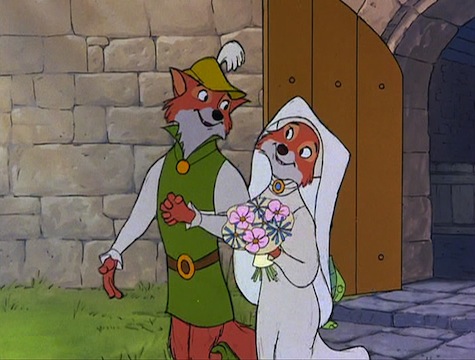
The Ending
Disney’s Robin Hood decides to one-up The Adventures of Robin Hood by having Robin save Friar Tuck and the entire town of Nottingham from jail. While ALSO emptying John’s treasury of coins, which, again, is John’s bedroom. That seems like an unnecessary risk to me (it wakes John), but then I’m not Robin Hood, so what do I know.
After that, it ups The Adventures of Robin Hood by staging the climactic sword fight (or sword and chair fight) in a flaming tower. It’s here that the Sheriff becomes truly monstrous, bursting through charred doors and towering over the now very small Robin Hood. It’s a rousing action sequence that ends with Robin leaping to his seeming death to escape.
Which is my second problem with the film (after Marian’s unimportance): it kind of just ends. Robin escapes unhurt, much to the relief of Little John and Skippy, but he leaves John in power. Penniless, but in power. There’s nothing to stop John from re-arresting all of the escaped villagers, or taxing them into oblivion again. Except Richard just shows up in the next scene and John’s in prison, so Robin and Marian can get married and apparently do it right there in their wedding carriage (at least, that’s the implication as they pull down the shades).
There’s an unfinished alternate ending (which you can find on the DVD) where Robin IS injured escaping from John, and Marian and Little John have to care for and hide Robin. Prince John himself finds Robin and is about to kill him when Richard appears and personally saves Robin and arrests his brother. That would have given Marian something to do in the last act and tied Richard’s return to Robin’s jailbreak. But apparently that ending was deemed too dark, so the cleaner, quicker version was released instead.
Drinking Game
Warning, this is four drink movie. It’s short and it looks like it’s going to be a two drink movie at most going in to the jailbreak sequence. But then Robin starts emptying out John’s treasury, which is nothing but bags of gold. So if you’re drinking every time someone handles a bag of gold, you will die.
Steven Padnick is a freelance writer and editor. By day. You can find more of his writing and funny pictures at padnick.tumblr.com.










